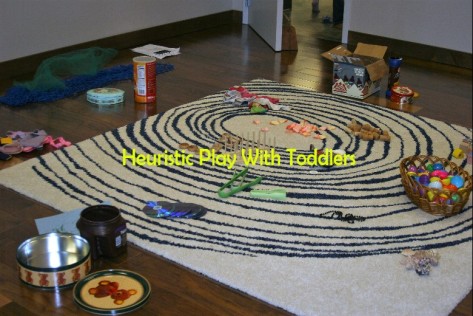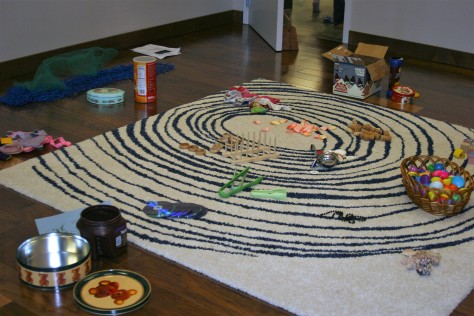
I am often asked to suggest art and craft ideas for toddlers. A toddler is not interested in making a product, they enjoy exploratory activities, where they can move around. I suggest sensory experience where they can use their whole bodies. This might be using art materials like clay or paint but can just as easily be other sensory materials, like ice, water, bubbles, goop, sand or natural materials. I have a sensory play Pinterest board if you are interested in more ideas (I’m happy to have new contributors too, post a comment if you would like to be added).
Another great activity to encourage toddler exploration is heuristic play.
Treasure Baskets (Heuristic Play for Babies)
Treasure baskets are sturdy baskets filled with safe, natural and household objects, which stimulate a baby’s natural curiosity, through their senses. They are presented to babies to explore from the time they are able to sit. The baby removes things from the basket to investigate the properties of the objects using their hands, mouths and eyes and ears . The adult’s role is to sit near the baby to offer comfort or support when needed. Treasure baskets could follow a theme like metal objects, wooden objects or black and white objects. You could choose things your baby is naturally curious about or try new objects. Always check the safety of the items, make sure they are not small enough to be swallowed, can’t trap little fingers and look out for parts that could break off. Also choose things that can be easily cleaned or replaced at little cost
Suggestions for objects to place in treasure baskets
- a lemon, lime or orange
- natural sponges
- wooden spoons
- tins with lids or tape the lid down and put something inside to make a sound.
- empty crisp packets
- wooden or metal egg cups
- napkin rings
- a soft blanket, cloth or scarf
- large shells
- A string of large beads
- laminated photographs
- a pumice stone
- large corks
- wooden nail brush
- shaving brush
- small boxes
- wooden bowls
- bunch of keys
- powder puff
- lavender bags (or fill with other herbs).
What is Heuristic Play?
When young children begin to walk and gain independence they are driven by a natural curiosity and urge to handle things and find out what objects can do. How often do we find ourselves asking them not to touch, finding that they have pulled things out of cupboards, emptied containers or posted raisins into the DVD player? Heuristic play allows toddlers to freely discover how things work, exploring concepts like posting, stacking and sequencing.
Heuristic Play offers children an opportunity to play freely with a large number of different objects and receptacles in a controlled environment without adult intervention (unless the child requests it). The term was coined by Elinor Goldschmeid and Sonia Jackson – heuristic coming from the Greek word ‘eurisko’ meaning to discover or gain an understanding of.
During a toddler session a variety of multi sensory materials (not toys) are spread around an otherwise empty room, free from all other distractions. Each child is given a selection of containers with which to explore.

The Adults Role
The adults sit quietly around the outside of the room so as not to distract the child’s natural exploration, they do not direct the play in any way and only support the child if they come to them for help, are distressed or they sense that their child has had enough.
At the end of the session children help to sort the materials putting them back in their correct bags with the support of the teacher. Objects are stored in labelled drawstring bags, for easy storage.

We do not call this ‘tidy up time’ as this is an abstract concept; instead it is merged into part of the experience.
How Do the Children Benefit?
There are many benefits to play of this kind :-
- Children will be engaged in self-discovery and test hypotheses
- Cognitive development is strengthened by working out how things work and fit together
- Develops fine muscle control
- Develops hand/eye co-ordination
- Encourages children to make choices
- There is no right or wrong way to do things therefore it is therapeutic and fully inclusive
- It sustains children’s natural curiosity
- Children modify and change what they already know to gain new knowledge
- Children become absorbed for long periods learning to explore without adult direction.
- It supports children’s natural ways of learning through schemas.

Materials I have used during heuristic play sessions
- shells
- pinecones
- conkers
- tins and boxes
- poster tubes
- curtain rings
- poker chips
- kitchen roll holders
- the insides from sticky tape
- scarves
- handbags
- ladles and large spoons
- plastic fillable eggs
- baskets
- cd’s
- socks
- strings of beads
- wooden blocks
- jam jar lids
- cotton reels
- pegs
- ribbon
- bunches of keys
- corks
- ping-pong balls
Is Heuristic Play the Same as Loose Parts?
Not really, although they are clearly related. The main difference is heuristic play is a deliberate attempt to engage children in exploratory play by putting the materials in a room free from all other distractions. Also the goal is for the children to explore without adult intervention. In loose parts play the objects are usually part of the pre-school environment and can be used in any way to enhance all aspects of play, the adults normally engage with the children to develop sustained shared thinking. Children engaged in loose parts play will often explore many of the characteristics of heuristic play and vice versa but they are similar, not the same. Heuristic play will naturally evolve into loose parts play as the children become older.

This is a lovely post. I also like that by using inexpensive and accessible items we can model the value in offering simple things for rich learning experiences to adults.
LikeLike
Yes totally true. I think it is important to highlight that often the most engaging toys cost very little.
LikeLike
This is a fantastic article! After reading this I have realised that I have always allowed my kids to learn this way, with out even realising it.. It’s so natural 😊
LikeLiked by 1 person